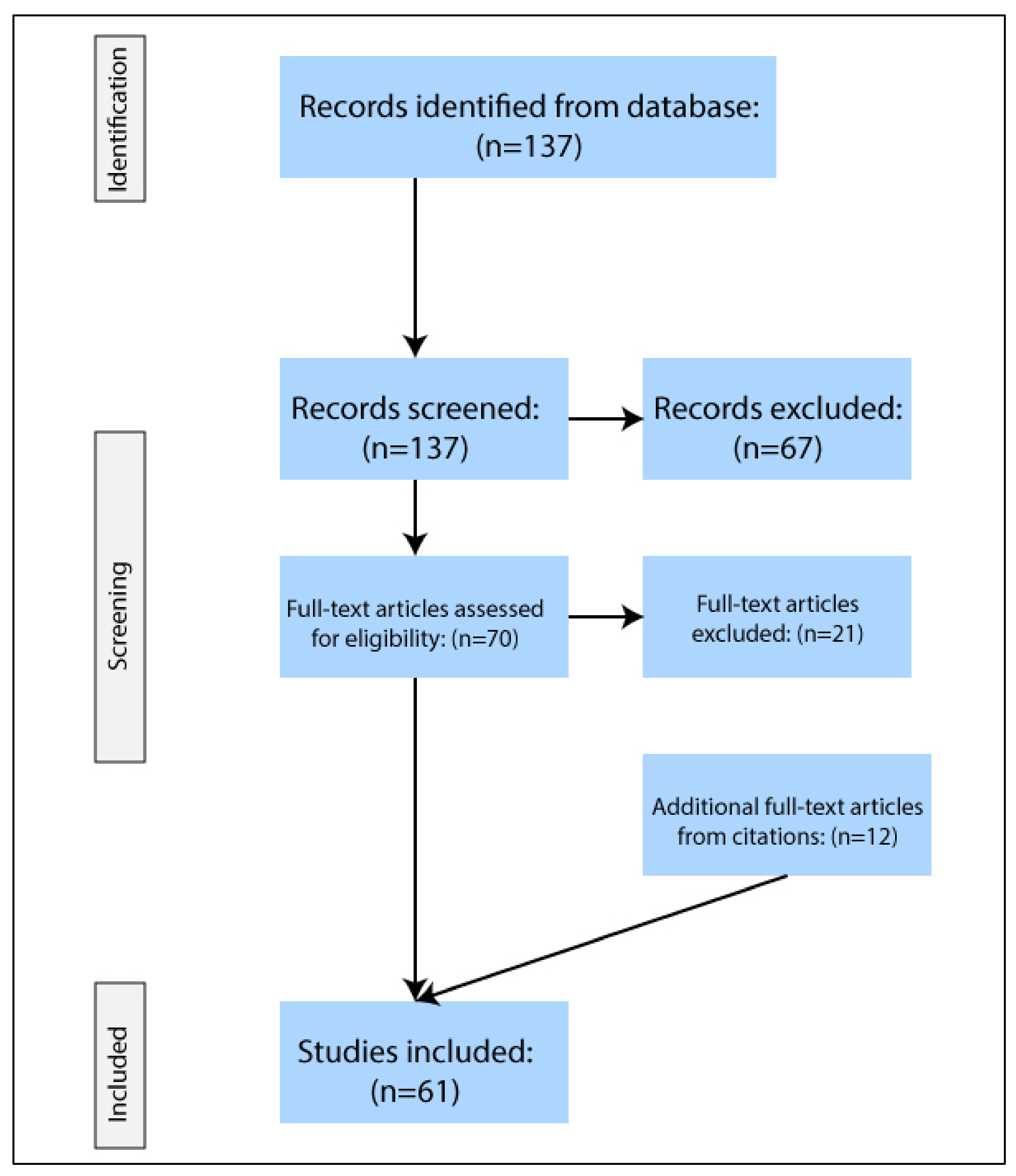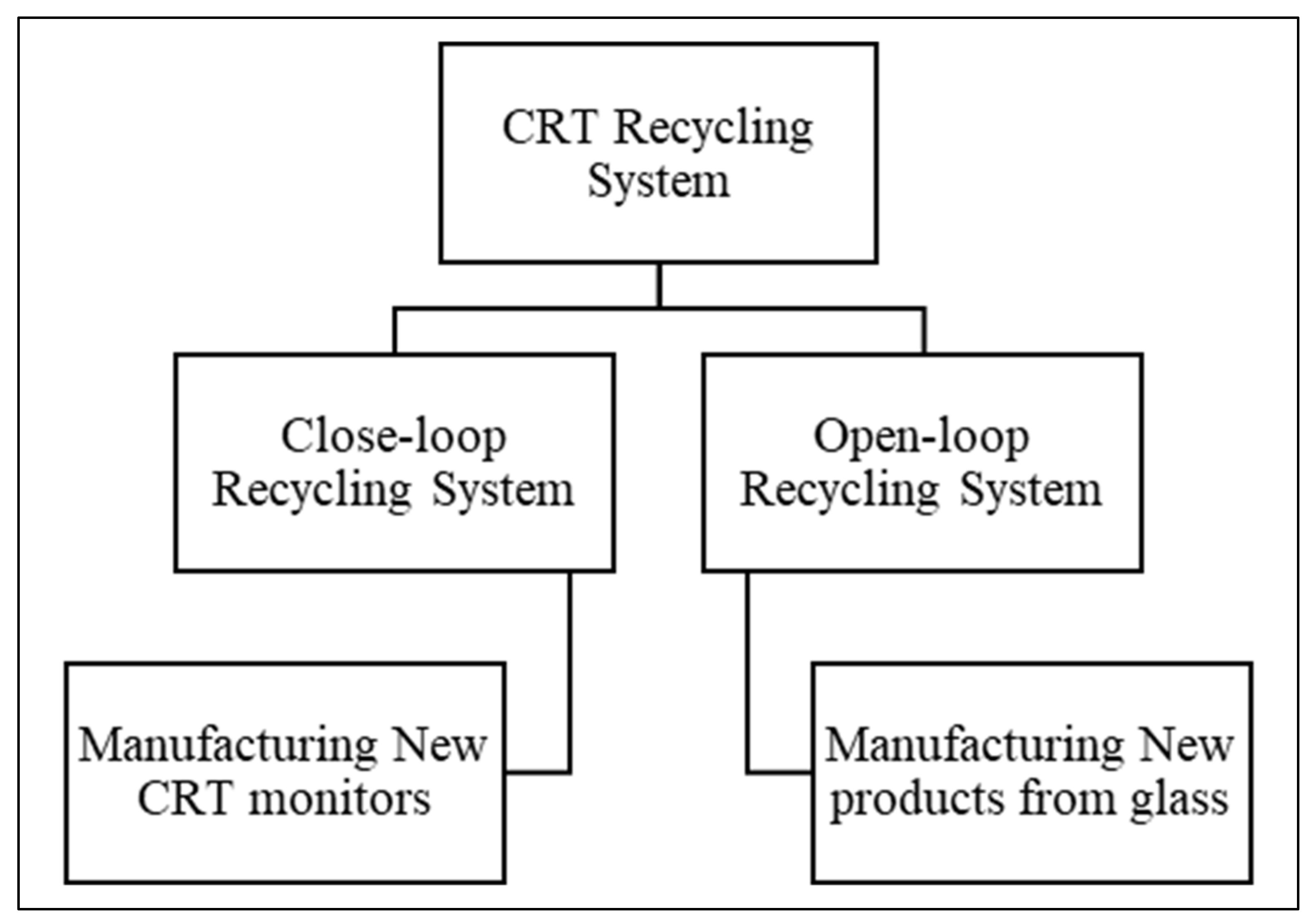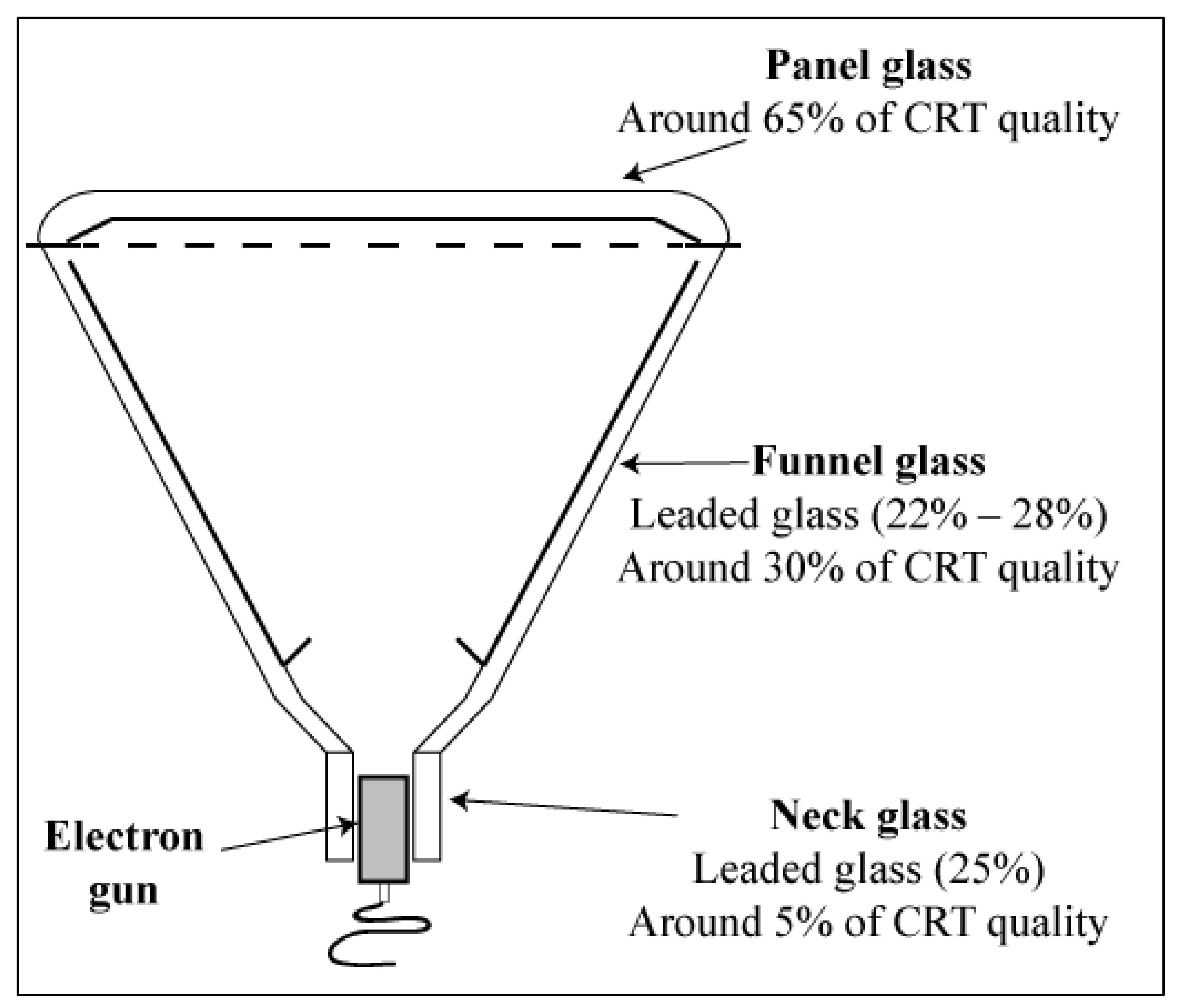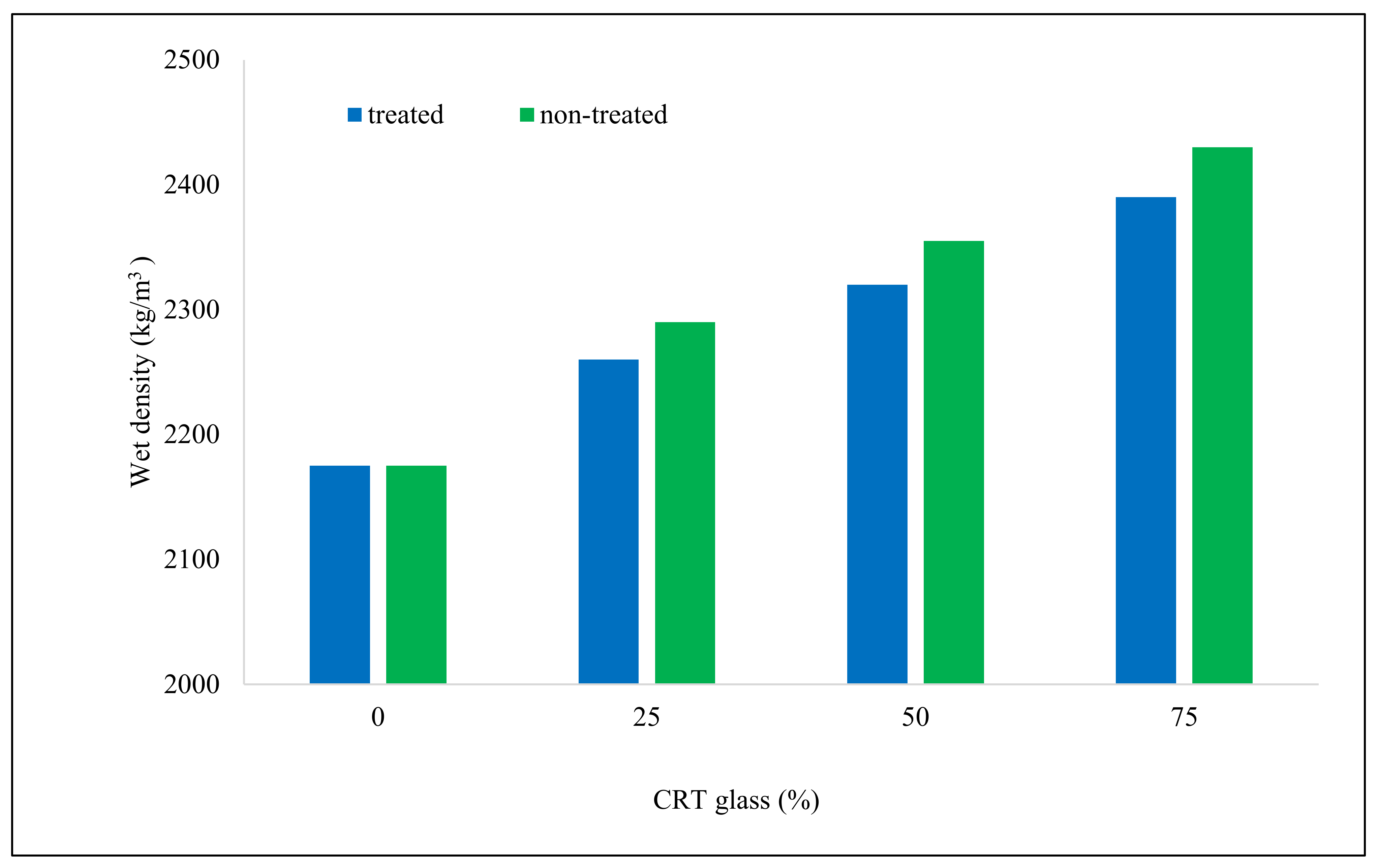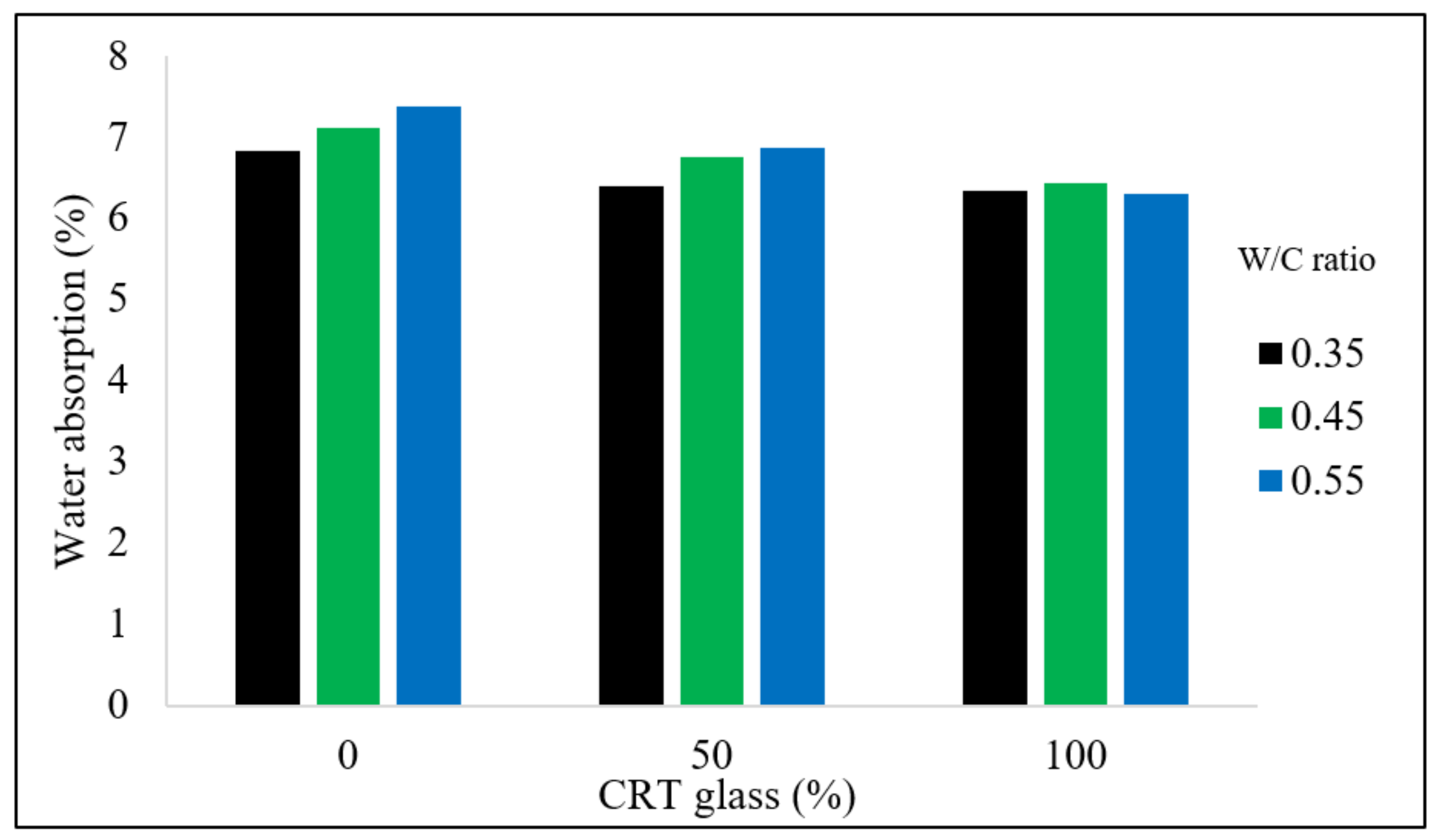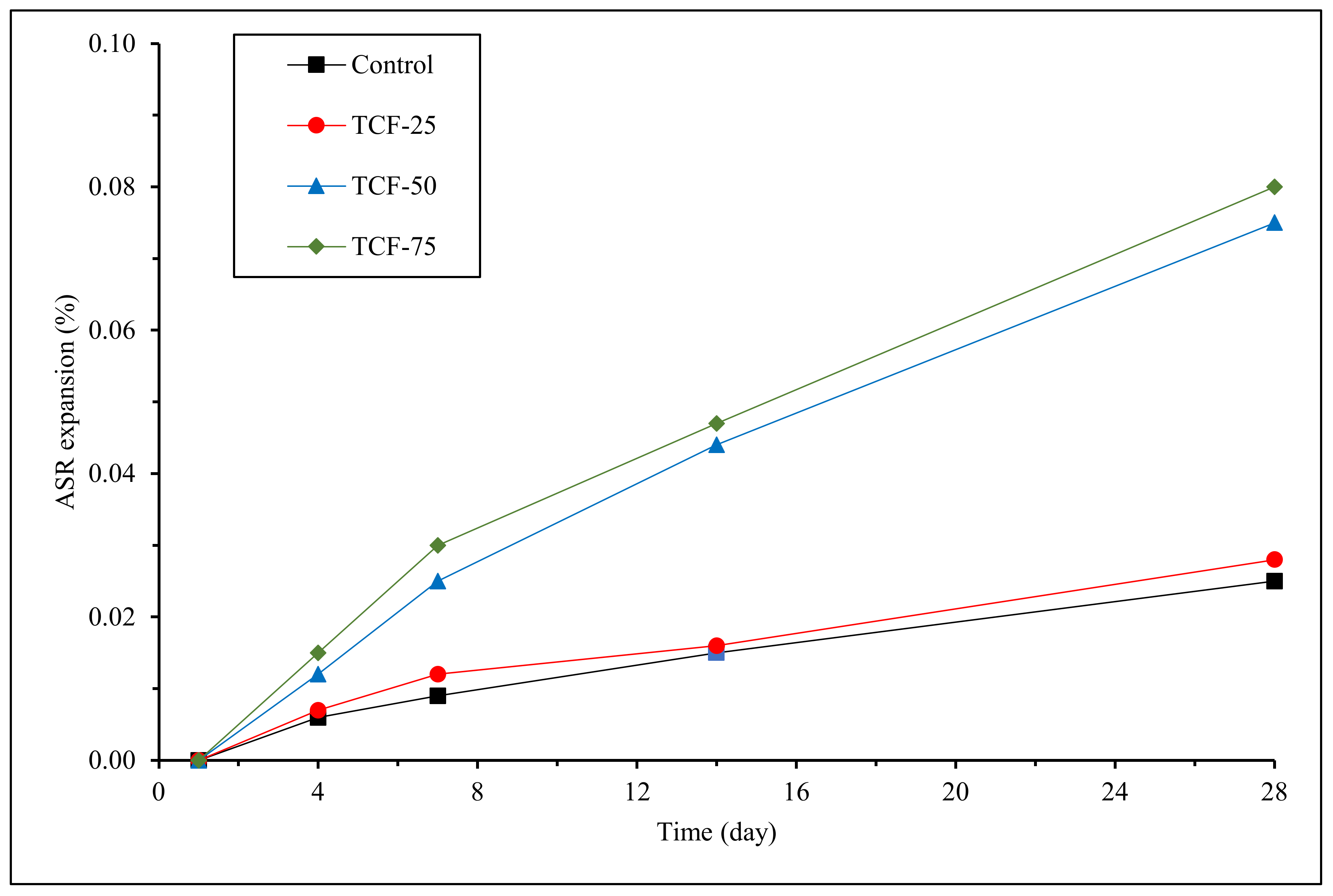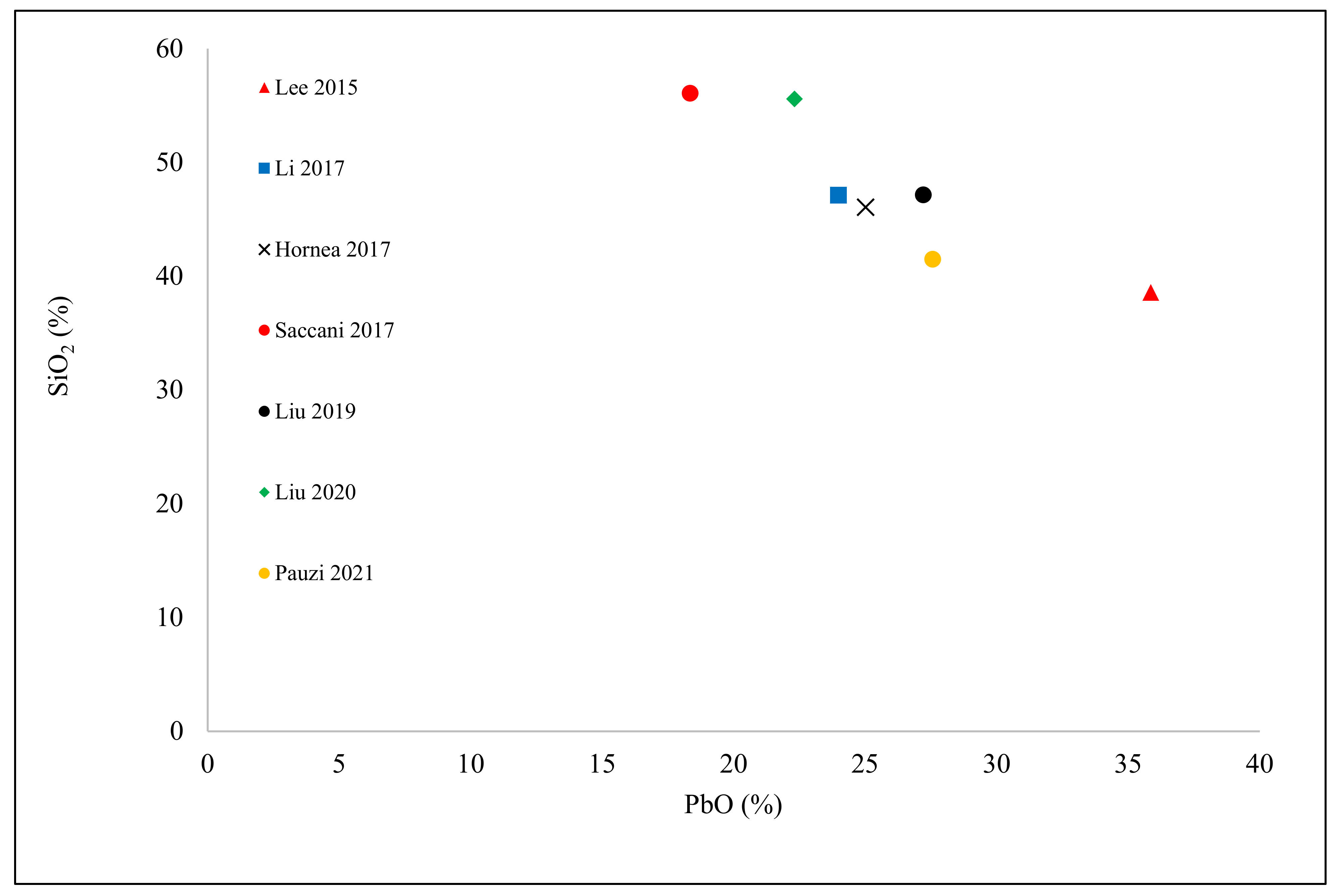1. Introduction
Concrete is the second most widely used material in the world [
1]. To produce concrete, huge amounts of aggregates, cement, and water and other resources are consumed annually. Using waste or recycled materials in concrete can reduce the amounts of quarried/virgin materials, which can be used to replace cement [
2,
3,
4,
5] or aggregates [
6,
7,
8,
9,
10]. Aggregates alone constitute roughly 70 to 80 percent of concrete, by volume, with around 25 to 35 percent of total aggregates produced globally being used in concrete. As such, the demand is noticeably growing, especially in developing countries [
11], where construction projects lack environmental impact assessment triggering as a result environmental concerns [
12]. In addition to that, the world consumption of aggregates surpasses 40 billion tons annually [
13]. The extraction of these large quantities has considerable consequences on biodiversity, landscapes and water supply [
14,
15]. These aggregates are categorized into fine and coarse aggregates. Typically, sand is used as the natural fine aggregate in conventional concrete. Since the extraction levels of sand are beyond the replenishment levels, solutions such as avoidance policies, alternative materials, and standards must be exploited to tackle the crisis of sand depletion [
16].
Reducing the amount of virgin aggregate in construction application is possible through the use of recycled or waste materials [
17]. Sustainable and economical alternatives include: crushed rock sand, industrial byproducts and recycled aggregates [
18]. A wide variety of recycled materials can efficiently replace aggregates in concrete, including glass waste. It is a widely used non-biodegradable material with different forms and shapes and versatile applications. Such various applications result in excessive amounts of glass waste each year that require prolonged time periods to break down naturally if landfilled [
19,
20,
21]. This glass waste is derived from containers, fluorescent lamps, and television screens [
22]. The European Union alone generated around 18.3 million tons of waste glass in 2012 [
23]. Nevertheless, this waste has a very high potential for recycling and achieved a high recycling rate [
24]. In fact, its very low permeability and high hardness of glass can enhance the performance of structural concrete [
25].
The United Nations has adopted a sustainable development agenda that includes 17 goals including infrastructure and sustainable cities which are specific to construction [
26]. In order to meet some of these goals, a rational utilization of natural resources used in construction is necessary. These include materials recycling which would reduce the amount of virgin materials used. Past research examined the effect of recycling glass as aggregates in cement-based materials. Adaway and Wang [
27] stated that using glass waste as a partial replacement of sand, especially at 30% replacement level, could contribute to the increase of the compressive strength of structural concrete. Another study investigated the effects of replacing fine and coarse aggregates with glass waste in concrete on durability related properties and revealed that the incorporation of glass waste resulted in an improvement in water absorption and carbonation resistance at late curing periods [
28]. Additionally, Wang et al. [
29] demonstrated that the properties of cement mortar could be maintained when replacing sand with liquid crystal display (LCD) glass at 10–20% replacement levels. However, some concerns arose regarding the use of glass waste in cement-based materials, in particular the evolution of alkali-silica reaction (ASR) and the weakening of the bond between the hydrated cement and aggregates [
30].
The cathode-ray tube (CRT) is made of 85% glass [
31], and could potentially be used in cement-based materials. The use of waste CRT glass in cement-based materials is associated with better environmental practices related to the proper waste management and mitigation of toxic waste disposal [
32]. In addition, recycling CRT glass waste in cement-based materials alleviates energy consumption, CO
2 emissions, and costs compared to landfilling [
33]. As early as 2004, CRT glass waste was used in concrete to replace fine aggregates where two main concerns were highlighted, leaching of heavy metals and ASR [
34]. In general, CRT glass waste can be used in different forms in concrete. Some studies used CRT glass waste as a replacement for coarse aggregates in cement-based materials. Pauzi et al. [
35] for example used CRT glass waste as coarse aggregates and noted that this replacement increased the slump but drastically decreased compressive, tensile splitting, and flexural strength. Further, Liu et al. [
36] replaced both fine and coarse aggregates with different amounts of CRT glass waste. The authors noticed an improvement in consistency and a decrease in strength and drying shrinkage.
Different studies have used CRT glass waste as a supplementary cementitious material (SCM) for its pozzolanic activity. Hilton et al. [
37] examined the environmental impact and performance of concrete containing CRT glass and other types of recycled glass powder as partial replacement for cement and found that the compressive strength of concrete was enhanced after one year of curing. Maschio et al. [
38] reported an increase in compressive strength and limited ASR when CRT glass of particle size smaller than 500 µm wa added to concrete. Grdic et al. [
39] investigated self-compacting concrete incorporating CRT glass of particle size less than 125 µm and found an improvement in consistency, compressive strength, tensile strength, and adequate durability. Walczak et al. [
40] showed that autoclaved aerated concrete using CRT glass waste as SCM had comparable mechanical properties to that of the control mixture without the detection of any harmful chemical compounds.
Owing to the high silica content in the CRT glass waste and ability to reduce the energy costs associated with the milling of glass to produce a powder, nearly most of the experimental studies that incorporated CRT glass in cement-based materials used it as a partial or total substitute for sand only. A number of review papers have already discussed the recycling of CRT glass in building materials [
41,
42,
43,
44]. However, there is a need for an updated overview that considers the latest research done related to the incorporation of CRT glass in cement-based materials in light of its significance to sustainability. The new aspects of this paper include a full review on the recent developments regarding the use of CRT glass waste in cement-based materials with emphasis on their fresh, mechanical, and durability properties. These properties include consistency, density, compressive, tensile, and flexural strength, modulus of elasticity, drying shrinkage and water absorption, alkali-silica reaction, lead leachability, and radiation shielding. The practicality of using CRT glass waste as fine aggregates in cement mortar and concrete is evaluated based on the results of experimental studies related to this topic in light of its contribution to sustainability. The new aspects of this paper compared with those of previous literature reviews are presented in
Table 1.
2. Methodology
This paper is a systematic literature review that presents an overview of the properties of cement mortar and concrete that include CRT glass waste as fine aggregates in accordance with PRISMA guidelines [
45]. These guidelines are a set of instructions that facilitate the reporting of systematic literature reviews. For the purpose of identifying relevant papers, keyword searching was carried out using Scopus database. A defined search query was used (
Appendix A). As a result of the search criteria, a total of 137 records were obtained. These records were screened to include only the experimental studies that used CRT glass in either cement mortar or concrete, thus excluding 67 records. Then, the remaining records were assessed for eligibility and 49 full-text papers were selected. The bibliography in the selected papers were examined for the detection of further related studies and an additional 12 studies were found eligible. Therefore, a total of 61 full-text papers were selected for the analysis. This is better illustrated in
Figure 1.
The papers varied between journal research articles, book sections, and conference papers. They were grouped according to the type of cement-based material and the date of publication to trace the direction of development of the topic. Full texts were screened, and data was then collected from the selected papers and categorized according to the main properties of cement-based materials mentioned earlier. Some studies used chemically treated CRT glass for the removal of its lead content. So, unless otherwise indicated, all “treated CRT glass” mentioned in this paper indicates CRT glass having its lead removed.
Section 3 presents an overview of the current situation of the recycling systems of CRT monitors, whereas
Section 4 shows the main characteristics of the CRT monitors with emphasis on the part made of glass.
Section 5 discusses the effects of including CRT glass on the consistency of cement mortar and concrete, while
Section 6 highlights its impact on the fresh and hardened density. In turn,
Section 7 analyzes the change in strength of cement mortar and concrete with the inclusion of CRT glass as fine aggregate. The modulus of elasticity and drying shrinkage are discussed in
Section 8 and
Section 9. The following three sections (10–12) considers durability related properties such as water absorption, alkali silica reaction, and lead leaching.
Section 13 debates the prospect of using CRT glass concrete in radiation shielding applications. Finally,
Section 14 concludes the paper and suggests recommendations for future research.
3. CRT Recycling
Since the 1950s, CRT has been the main constituent of TVs and computer screens [
46,
47]. However, with the spread of LCDs and plasma display panels (PMDs), CRT monitors are becoming obsolete [
43,
47]. This has led to the disposal of huge quantities of CRT monitors mainly in landfill sites and this will possibly continue in the coming decades causing major environmental concerns [
48,
49,
50,
51]. For example, in China alone, about 43 million tons of CRT monitors were discarded in 2013 [
52]. The environmental concern is due to lead and other heavy metals content found in CRT glass [
53].
Appropriate recycling of CRT glass should be performed to avoid such environmental problems. There are two categories of recycling CRT: closed-loop recycling and open-loop recycling.
Figure 2 summarizes the typical recycling system of CRT glass [
31].
The first includes the reuse of CRT glass in the manufacture of new CRT glass shells after proper pre-treatments [
44]. Yet, due to lower demand of new CRT monitors, this type of recycling is not feasible anymore [
54,
55]. In contrast, open-loop recycling is a more difficult process [
47]. It includes utilizing CRT glass waste in the creation of new products, but it is more feasible since it has an economic and environmental value [
53]. New products include construction materials, where richness in silica and low water absorption properties of CRT glass waste makes it a suitable alternative to sand or pozzolan in concrete [
43].
Figure 2 summarizes the typical recycling system of CRT glass.
4. Characteristics of CRT Glass
The CRT monitor is a vacuum tube that generates image when an electron ray hits a phosphorescent surface [
31,
47,
53]. It is made up of three main parts: electron gun, front panel glass, and funnel glass [
56]. The front panel, funnel, and neck glass contributes to about 65%, 30%, and 5%, respectively [
49,
57]. Different chemical compositions are found in the various glass components, each containing different chemical and physical forms of lead [
47].
Figure 3 illustrates the composition of a typical CRT monitor [
58].
In general, CRT monitors can be divided to two categories: monochrome (black and white) and colored CRT. Silica is the main component of CRT glass. It is present in all types of glasses in both monochrome and color CRT ranging from 50 to 66% of total weight. Barium oxide is also present in panel and funnel glass, while lead oxide is present in neck glass of both monochrome and color CRT and in funnel glass in color CRT, in addition to less quantities of various other oxides and heavy metals [
59]. Chemical structure of funnel and panel glass in both monochrome and color CRT is presented in
Table 2 [
49,
60]. It can be noticed that funnel glass and panel glass in monochrome CRT have almost the same chemical composition, whereas the case is different in color CRT, especially in lead, barium, and strontium content.
Figure 4 presents the content of silica and lead in CRT funnel glass used in cement-based materials from selected literature [
36,
52,
61,
62,
63,
64,
65]. It was found that usually, CRT funnel glass used in literature contained more lead (18–35%) than that expected according to earlier records (15%) [
49,
60]. This variation might be due to CRT monitors originating from different manufacturers. The silica content, conversely, was as anticipated.
6. Density
Zhao et al. [
71] found that increasing the CRT glass replacement from 0 to 75% caused a rise in wet density of mortar from 2176 kg/m
3 to 2408 kg/m
3. This is expected since CRT glass has a higher density (3042 kg/m
3) than river sand (2620 kg/m
3). These authors reported similar results in another study [
76], where the wet density of concrete increased from 2914 to 2992 kg/m
3 after replacing 75% of sand with CRT glass by volume. Additionally Romero et al. [
80] noticed an increase in wet density of concrete when replacing limestone sand with CRT glass. Zhao and Poon [
86] replaced sand in mortar by both treated and non-treated CRT glass at substitution levels 0, 25, 50, and 75%. The wet density increased with the increase of substitution level. Yet, at the same substitution level, non-treated CRT glass mortar had a higher density than treated CRT glass mortar. This is better illustrated in
Figure 5 [
86].
Ling et al. [
87] replaced sand with beverage glass, non-treated CRT glass, and treated CRT glass at 0, 25, 50, 75, 100% by volume. Hardened density of mortar increased by 11.2% for treated CRT funnel glass and 14.6% for non-treated CRT glass when comparing with the control concrete mixture at replacement level of 100%. Choi et al. [
72] observed an increase by around 17% for CRT glass at 100% replacement level regardless of the water-binder ratio and mineral admixture used. Yildirim [
88] substituted CRT glass for sand at replacement levels 0, 5, 10, 15, and 20% by weight. The author indicated that the density of hardened concrete increased up to 15% then decreased when CRT glass content is 20%, finding a similar trend in an earlier study [
89]. Song et al. [
90] replaced sand with CRT glass at replacement levels of 0,20,40,60,80,100% by weight, and different particle size groups (4.75, 2.36, 1.18, 0.60 mm) for 100% replacement level. The hardened density of concrete increased gradually as replacement levels increased, from 2303 kg/m
3 for control mix to 2423 kg/m
3. At 100% replacement level, hardened density decreased as the grain size of CRT glass reduced (
Figure 6) [
90].
As is expected, including CRT glass in concrete or mortar led to an increase in the fresh and hardened density. This is mainly because of the higher density of treated and non-treated CRT glass compared to that of sand. While higher density is not preferred in general for structural concrete, high density concrete is appropriate for some engineering applications, such as radiation shielding [
91].
8. Modulus of Elasticity
Hui and Sun [
66] reported that the modulus of elasticity of mortar at 28 days increased from 7.89 GPa for the control mixture to 12.47 and 10.26 GPa for non-treated and treated CRT glass representing 58% and 30% increase, respectively. Zhao et al. [
71] noticed a gradual increase in the modulus of elasticity of mortar with increasing amounts of CRT glass. The authors found a high correlation between modulus of elasticity and compressive strength. Zhao and Poon [
86] observed an increase of modulus of elasticity with the increase of both non-treated and treated CRT glass in mortar. At the same replacement level, the non-treated CRT glass had slightly higher values than treated CRT glass. Ling and poon [
104] reported that using CRT glass caused an increase in modulus of elasticity at some replacement levels and a decrease at other replacement level. Results of modulus of elasticity varied between 16.4 GPa and 20.9 GPa. Bawab et al. [
108] partially replaced sand with CRT glass and reported an increase in modulus of elasticity at 10% replacement level then a decrease at further replacement levels. This was noticeable in the behavior of reinforced concrete beams, where higher modulus of elasticity resulted in less deformation at the same load.
In contrast, Zhao et al. [
76] found that including CRT glass as fine aggregate caused a slight reduction in modulus of elasticity of about 7 when 75% of sand was replaced with CRT glass in concrete. However, the reduction in compressive strength was much higher at the same replacement level. A similar result was found by Liu et al. [
109] when sand was partially replaced with 30, 60, 100% CRT glass by volume. It was found that the static modulus of elasticity of concrete decreased from 31.59 to 26.32 GPa as the replacement increased from 0 to 100%. The authors observed that dynamic static modulus of elasticity also decreased when using more CRT glass content. Yildirim [
88] reported an increase in the modulus of elasticity modulus at 5 and 10% CRT replacement while Song et al. [
90] noticed that the modulus of elasticity of concrete with 100% CRT glass replacement decreased by 13.2% when compared with the control mixture. It was revealed that a smaller maximum particle size of CRT glass enhanced the modulus of elasticity. Wang et al. [
82] observed a 15.7% decrease in dynamic modulus of elasticity when replacing 25% of the sand with non-treated CRT glass. Yet, an increase in dynamic modulus of elasticity was noted between non-treated and surface treated CRT glass at 25% replacement level.
The findings of the modulus of elasticity from literature [
71,
86,
104] suggest that there are no consistent results concerning the effect of CRT glass on the modulus of elasticity of mortar and concrete. This possibly indicates that changing the type of fine aggregates in cement-based materials has a marginal impact on the corresponding modulus of elasticity.
9. Drying Shrinkage
Hui and Sun [
66] reported that the shrinkage of mortar increased with the increase of CRT glass content. When applying fly-ash as SCM, the drying shrinkage of mortar including CRT glass at 56 days is below the limit of 0.075% specified by the Australian Standard AS 3600 [
110]. When using slag, the length change approaches this limit. Zhao et al. [
71] found similar results where the use of CRT glass caused an increase in shrinkage length change. However, the drying shrinkage of the mortar specimens having CRT glass substitution levels of 50% and 75% exceeded the acceptable limit for mortar mixtures. Zhao and Poon [
86] noticed that CRT glass increased the drying shrinkage of mortar. Yet, all treated CRT glass mortar mixtures and those incorporating up to 50% non-treated CRT glass were below the acceptable limit.
On the contrary, Ling and Poon [
104] found that using CRT glass reduced the drying shrinkage gradually owing to the low water absorption of glass. The same authors found similar trend in other studies [
67,
70,
87,
98,
111,
112,
113]. Zhao et al. [
76] also observed a reduction in shrinkage with increasing amounts of CRT glass in mortar. The authors argued that the dying shrinkage was directly related to compressive strength, and the reduction of drying shrinkage was explained by the lower compressive strength upon the inclusion of the CRT glass [
76]. Wang et al. [
82] noted that using both treated and non-treated CRT glass led to a reduction in drying shrinkage of concrete. However, treated CRT glass caused more reduction. This reduction was explained by the low water absorption rate of CRT glass [
76,
98] and the angular shape of CRT particles [
68,
71].
10. Water Absorption
Ling and Poon [
112] replaced sand with up to 100% treated CRT glass in concrete paving blocks and found that using CRT glass in concrete decreases the water absorption. This was expected since the CRT glass has a lower absorption than sand [
113]. Kim et al. [
77] noticed a reduction in permeability when adding CRT glass to concrete. This was more apparent with higher water binder ratio, where 15% reduction in absorption was observed at 100% CRT replacement (
Figure 7). Song et al. [
90] found similar results, where increasing CRT glass content gradually reduced water absorption. The authors also observed that a smaller maximum particle size of CRT glass led to further decrease in water absorption. Ouldkhaoua et al. [
103] also observed that using CRT glass reduced water absorption of concrete. Liu et al. [
109] reported a decrease in water absorption of concrete from 3.64% for the control mix to 3.19% when CRT glass fully replaced the sand. This is conflicting with the findings of other studies [
70].
Yildirim [
88] indicated that the water absorption of concrete decreased from 6.46 to 6.05% for mixtures made with 0% and 10% CRT replacement, respectively. A subsequent increase to 6.97% was observed at 20% replacement level. The author suggested that increasing the CRT glass replacement level from 15 to 20% causes a higher porosity in concrete specimens. A similar explanation, i.e., increase in void content in the cementitious matrix, was given in another study, where the water absorption increased in ultra-high performance concrete from 1.74% for control mixture to 2.4% for the mixture sand fully replaced with CRT [
62].
In general, the use of CRT glass led to the reduction of the water absorption of cement mortar and concrete. It is suggested that near-zero water absorption of glass is the main reason behind this effect [
25]. Yet, the porosity of the cement-based materials must be taken into consideration for further insight on the effect of CRT glass.
11. Alkali-Silica Reaction (ASR)
Hui and Sun [
66] reported that using CRT glass in mortar caused an increase in expansion due to ASR. The authors observed that there was a negligible increase in expansion after 14 days of exposure in the control mortar mixture, while mortar mixtures containing CRT glass continued to expand. In addition, the authors mentioned that the use of fly ash as SCM led to a decrease in expansion due to ASR [
114], where mortar incorporating ground granulated blast furnace slag surpassed the allowed range of 0.1% at 14 days specified by ASTM C1260 [
115].
Similarly, Ling and Poon [
67] noted that treated CRT glass increased ASR expansion values. However, the presence of fly ash in concrete mitigated the expansion mainly due to the pozzolanic reaction which has led to a reduction in alkali content [
116,
117]. Zhao et al. [
76] confirmed these results, where using treated CRT glass increased ASR but within the allowed limit due to the use of fly ash (
Figure 8). Wang et al. [
82] found similar results and proved that surface treatment of CRT glass can reduce ASR with or without the presence of pozzolanic materials. These results are in agreement with those of other works [
80], where the expansion of all concrete mixtures that used CRT glass exceeded the permitted limit due to the absence of fly ash, and the maximum recommended ratio of CRT glass to replace fine aggregates was 10% by volume. Further, Bursi et al. [
118] replaced 25% sand with CRT glass in mortar. The authors suggested that treating the CRT glass by nitrilotriacetic acid effectively reduced the expansion caused by ASR when compared to mortars containing non-treated CRT glass.
Yildirim [
88] reported that increasing CRT glass content in concrete led to an increased expansion due to ASR. However, the addition of fly ash in concrete containing CRT glass reduced the expansion due to ASR. Ouldkhaoua et al. [
78] found that ASR increased as CRT glass content increase, due to the internal cracks caused by higher SiO
2/CaO ratio [
119]. Nevertheless, the authors however that the expansion rates were lower when metakaolin was present in the concrete mixture, where the effect was more noticeable at higher replacement levels.
It can be concluded that CRT glass caused an increased expansion due to ASR. To mitigate this effect, authors recommended the use of pozzolanic SCM, mainly fly ash and metakaolin. Using such SCM generally led to a denser microstructure of the cement-based materials contributing to less expansion due to ASR.
12. Lead Leaching
Due to the lead content present in the CRT glass, lead leaching has always posed a concern for its possible applications. Rather than acid treating this glass for the removal of lead, which can be inefficient and costly, lead found in CRT glass can be effectively encapsulated in the cementitious matrix. Kim et al. [
120] used several types of biopolymers to encapsulate CRT glass into concrete, resulting in a negligible lead leaching values approaching zero. These results are in agreement with those obtained in other work [
121], where biopolymers contributed in the creation of concrete systems having significantly decreased lead leaching. In fact, Romero et al. [
80] reported that lead leaching in concrete containing 20% CRT glass as sand replacement is within the allowable limit if a biopolymer was added into the mixture. Another method of encapsulation of lead found in CRT glass was the use of graphene oxide nanoparticles, where graphene oxide counteracted the adverse environmental impacts of waste CRT glass and improved the mechanical properties of cement-based materials using CRT glass as well [
122,
123].
Ling and Poon [
67] reported that lead leaching of mortar using treated CRT glass is below the detection limit of 0.06 ppm according to Toxicity characteristic leaching procedure (TCLP) [
124]. It is even lower than that of treated CRT glass before using it in the mortar, which possibly means that alkalinity of cement mortar effectively reduces lead leaching [
125,
126]. Moreover, the use of fly ash further contributed to reducing the lead leaching, through the products formed by the pozzolanic reaction [
127]. The same authors [
104] assessed the leaching of lead and barium of both treated and non-treated CRT glass in concrete. It was found that all concrete mixtures were under the permitted limit for barium leaching. However, for lead leaching, the concrete mixtures containing 50% and more non-treated CRT glass exceeded the acceptable limit, while all concrete mixtures with treated CRT glass were below the limit. The authors suggested using a maximum of 25% replacement of non-treated CRT funnel glass for limiting lead leaching. Similarly, Zhao et al. [
71] found that increasing the non-treated CRT glass in mortar resulted in lead leaching above the acceptable limit. However, these leaching values were much less than those of CRT glass alone, indicating that the alkalinity of concrete limited the lead leaching.
Another factor influencing lead leaching in concrete is the method of compaction. Lin and Poon [
112] prepared paving blocks using dry-mixing. It was noticed that the control mixture and 50% treated CRT glass concrete were within the allowable limit. This was a result of manual compaction during casting which led to breakage of glass, and increased lead leaching. To prove this claim, the authors tested concrete mixtures with 100% CRT glass in two different methods: first by manual and mechanical compaction, second by only mechanical compaction. As expected, concrete mixtures that were compacted mechanically only had an acceptable lead leaching values whereas concrete mixtures that were compacted both manually and mechanically had higher values than the limit.
Lead leaching in cement-based materials might be the main concern when replacing sand with CRT glass. When the alkaline environment of the cementitious matrix is not enough for the immobilization of lead found in CRT glass, a number of methods can be utilized: (a) treating CRT from lead (b) limiting the amount of CRT glass, (c) using fly ash, (d) encapsulation techniques. The mechanisms of these methods are explained in
Table 7.
13. Radiation Shielding
Ling et al. [
87] noticed that radiation shielding properties of mortar were improved with both treated and non-treated CRT glass. This was explained by the dense particles that interacted with X-rays reducing the depth of its penetration. Additionally, the authors found that CRT glass further enhanced the radiation shielding properties since they absorb more radiation photons. The same trend was observed in several other studies [
69,
98,
112], where it was also realized that the presence of lead decreases the energy of radiation. Choi et al. [
72] found that using CRT glass in mortar improved radiation shielding properties regardless of water to cement ratio and SCMs used. Liu et al. [
107] noted that replacing high density magnetite sand with CRT glass enhance the mass attenuation coefficient. However, this replacement has about the same γ-ray radiation shielding properties. Tian et al. [
128] reported that the protective ratio of concrete related to radiation shielding significantly improved when using CRT glass, increasing from 76% at the control concrete mixture to 83% when fully replacing the aggregates with CRT glass.
CRT glass effectively improved the radiation shielding properties of concrete when compared to sand. Based on this specific benefit of CRT glass, it could be used in a wide variety of applications related to radiation shielding, such as nuclear power plants and medical facilities [
42].
The effectiveness of using CRT glass waste as an alternative to natural heavyweight aggregates in the production of radiation shielding concrete is also associated with less costs. Heavyweight aggregates used in radiation shielding applications are expensive, so there is a demand to find substitutes [
129]. Only one study conducted a cost analysis of using CRT glass as a replacement to sand in concrete and found an increase in the material costs [
76]. However, the study did not take into consideration the costs of natural heavyweight aggregates, such as hematite, in comparison with CRT glass.
14. Concluding Remarks and Recommendations
In the past few decades, the production of concrete has raised significant environmental concerns not only related to CO2 emissions, but also in regard to the depletion of natural resources. It is known that concrete consumes large amounts of natural resources, specifically rocks and sand. The latter, while being largely available and easily extracted, is diminishing. Thus, researchers should be encouraged to search for and test possible replacements of sand in concrete derived from waste materials or industrial byproducts. This paper discusses a possible substitution of sand in concrete known as CRT glass waste.
It was established through this literature review that recycling this type of waste in cement-based materials as a replacement to sand enhances some properties of concrete. Using CRT glass waste in cement-based materials improves its consistency due to its smooth surface and very low water absorption. In some cases, it improves the compressive, flexural, and tensile splitting strength. When used in mortar or concrete, CRT glass waste reduces the drying shrinkage and water absorption properties, where this could be beneficial in many structures such as water retaining structure. For alkali-silica reaction, using SCMs such as fly ash or metakaolin mitigates the risk of alkali silica reaction in concrete containing CRT glass. Lead leaching can be alleviated through various techniques, including acid treatment, encapsulation using biopolymers or graphene oxide, addition of fly ash, or limiting the quantity of CRT glass in the mixture.
Based on the conclusions drawn, further studies should be conducted to extend the knowledge about using CRT glass waste in cement-based materials. These might include the search for techniques to maintain the strength of cement-based materials after replacing sand with CRT glass at full or high replacement levels. In addition, more durability related issues, such as freeze-thaw resistance, carbonation resistance etc. might be assessed for a better insight on the long-term effects of the substitution of sand with CRT glass. Furthermore, the use of CRT glass in structural concrete is not well explored. More studies should be concerned with its effects on the various issues related to structural members such as shear behavior of reinforced concrete beams or creep in reinforced concrete columns.
